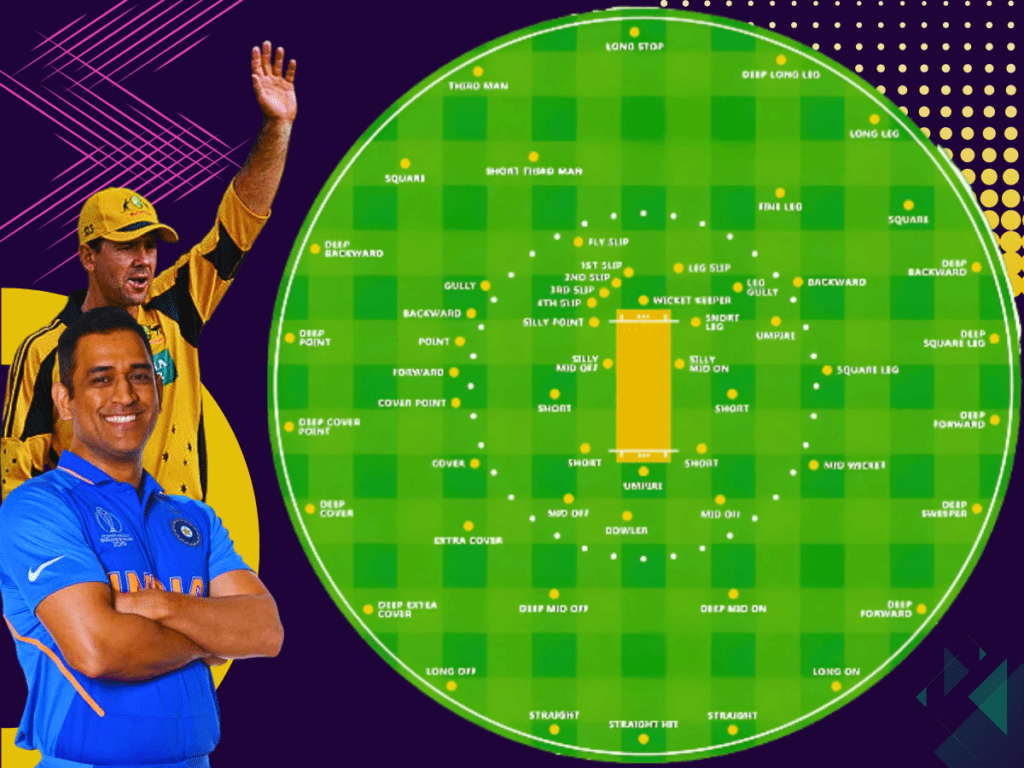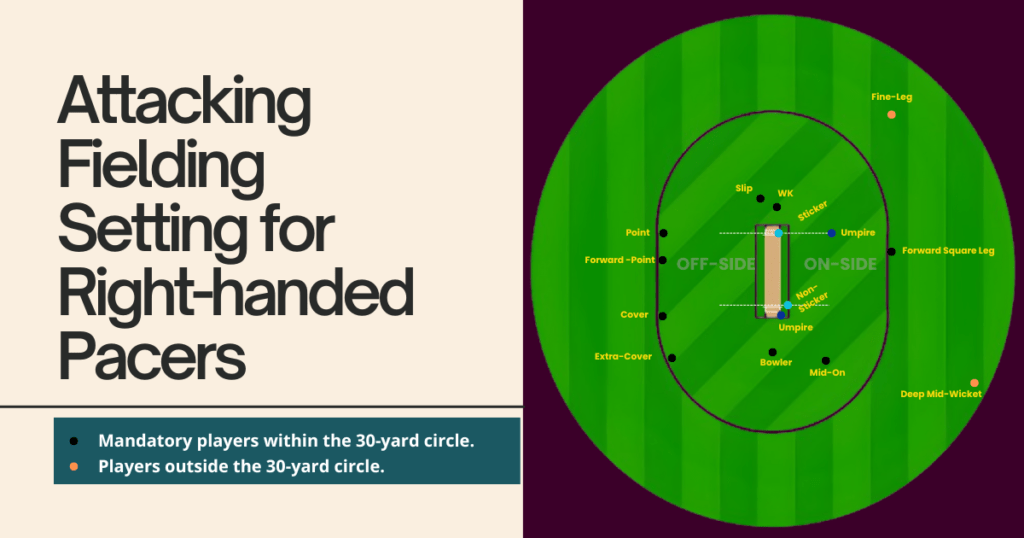
Cricket ground fielding positions in powerplay represent a strategic chess-like arrangement where 11 players meticulously position themselves to maximize defensive capabilities and potential wicket-taking opportunities across various match formats.
It is almost a headache to set cricket fielding positions in powerplays. The powerplay overs have two sides. It is like a double-edged sword. There is an instance for setting a platform for big scores for the batting team.
Bowlers, at this crucial stage, need to be more determined and place accurate deliveries according to the game plan. Cricket ground fielding positions in powerplays are vital because they help to maintain run rates and give wickets. Setting the right cricket fielding positions of 11 players making paramount to success in this crucial phase of the game.
Think about placing a cricket field setting in the powerplay that does not only restrict the scoring but at the same time increases the chances of getting wickets. This guide assures you of that precise plan.
Here, we describe various mindsets of cricket field settings in powerplays for T20s and ODIs. Be ready for this master of cricket field setting in the powerplay.
Here are the keys to opening the secrets to building the challenging field and swinging the odds in your team’s favour.
Table of Contents
What is Powerplay?
A powerplay is part of the aggregate of overs in a limited-overs cricket match. It is that fielding restricted regulation in which fielders remain confined to a 30 yard circle. The powerplay overs are vital in ODIs and T20s matches.
It only permits a limited number of fielders to be beyond a given circle on the field. Batters of the game also benefit because it is easier for them to hit the ball and ensure faster runs. That is like offering the hitters a license to make things quick within the field.
The rules of powerplays are different according to the formats. It helps to set how many fielders can be outside the 30-yard circle. Sometimes, slow overrate makes some difference with the fielding positions.
Importance of Cricket Fielding Positions in Powerplay
Setting the Tone: The cricket ground fielding positions in powerplay often dictates the pace for the rest of the game. While a good beginning automatically puts the batting side in a commanding position, a poor beginning may prove instead troublesome to come out of.
Aggressive Scoring: Because of fielding restrictions, batters hit with power freely. The high run rate is vital in the short format of cricket, such as ODIs and T20s.
Momentum Building: The batting team can seize control and gain momentum by employing effective powerplay strategies. The fielding team may face challenges in reversing this process.
Tactical Flexibility: The powerplay gives a tactical advantage to both teams. Fielders can alter their positions depending on the situation. The batters have the choice to play attacking or defensive. There were 9 fielders within the 30 yard circle.
Entertainment Value: The powerplay overs entertain the spectators. People love to watch more Boundaries and Sixes. It makes cricket engaging to the viewers.
Basic Rules of Powerplay in Cricket
There are several cricket ground fielding positions in powerplay overs in the T20 and ODI games where batters get to attack, and bowlers find ways to get wickets. While the rules of powerplay remain the same in both formats, there are some differences also.
Powerplay in T20s:
First six overs: The rules maintain by the umpires for fielding restrict the number of players at any given time to be beyond a 30 yard circle up to two. It is valuable because it allows a batter to hit the ball and get quick runs on the ground.
Seventh to twenty overs: The bowling team only has limitations to the maximum of five players outside the 30 yard circle. It helps the bowling team by putting brakes on the scoring.
Powerplay in ODIs:
First ten overs: The fielding team can only have two fielders beyond the 30-yard circle, like T20s.
Eleventh to forty overs: Outside the 30-yard circle, the fielding team can have four players at any time on the ground.
Forty-one to fiftieth overs: The fielding team must have a maximum of five players outside the circle. Besides, it offers the bowling team even more ways to break partnerships and make economical overs.
Basic Cricket Ground Fielding Positions in Powerplay
The cricket fielding positions in powerplay overs in ODI cricket are within the first ten overs. In T20 cricket, this is within the first six overs. These overs sometimes and very often dictate the pace of the match.
An outstanding cricket fielding position in powerplay is also crucial at this stage. It can change the momentum of the game. Below is an explanation of how various cricket fielding positions11 players in a powerplay might affect the strategies of a team:

There are also several vital attacking positions such as – short leg, silly mid, silly point, fly slip, leg gully, short mid, short leg.
Know all the Strategic Cricket Field Positions name for T20s & ODIs
| Cricket Field Positions Name | Purpose | Impact |
|---|---|---|
| Wicket keeper | Prevent runs and dismiss batsmen | Provides critical team insights and communication |
| Slips | Catch bat edges | Force batters to play cautiously |
| Deep Fine Leg | Control boundary shots | Limit big-hitting potential on leg side. |
| Square Leg | The square leg position is an excellent catching position. | The square leg position can pressure the batters on leg side and generate catching opportunities and reduces the run rate. |
| Backward Square Leg | Prevent aggressive shots | Force defensive batting strategies |
| Deep Mid-wicket | Block on-side scoring | Prevent powerful six and boundary hits |
| Mid-On | Guard boundaries and catch | Restrict off-drive scoring on leg side. |
| Long On & Long Off | Stop boundaries and catch high balls | Provide crucial defensive coverage near boundary rope. |
| Gully | Catch edges without conceding runs | Make batters more cautious |
| Extra Cover | To pause boundaries and singles. | Disrupt off-side scoring |
| Mid-Off | Shutdown singles and boundaries | Challenge batters’ shot selection |
| Backward Point | Halt singles and create catches | Potential for dismissal through cut shots |
| Third Man | Save runs and catch balls | Manage match tempo |
Cricket Fielding Settings in Powerplay for ODIs & T20s
This time, we discussed the most effective way to set an attacking cricket field setting in powerplay overs. In particular, it examines how proper fielding can help a team in a match, particularly in the initial stages.
To this spell, this point focuses on the positioning of fielders, such that they exert pressure on the batting side and deny them multiple scoring chances.
Cricket Field Setting in powerplay for Right-Handed Pacers
- Forward Square-Leg
- Mid-on
- Extra Cover
- Point
- Slip
- Fine Leg
- Deep Mid-wicket
- Cover
- Forward Point

Cricket Fielding Positions11 Impact on Right Handed Batsmans:
Right-handed fast bowler, exclusively concentrating on the off-side and middle of the wicket. In an attacking field, positioning fielders within the 30-yard circle as per rule and bowling according to the fielding positions helps control scoring opportunities for right-handed batters.
However, the batsman has to survive the initial period in front of the field. Once he does so, there is ample scope for scoring boundaries.
N.B. During any cricket match, you’ll see a maximum of five fielders positioned on the leg side—this rule applies throughout the game, even in powerplay overs.
Cricket Field Setting in powerplay for Left-Handed Pacers
- Mid-off
- Cover
- Cover Point
- Point
- Slip
- Mid-on
- Mid-wicket
- Third Man
- Deep Square-Leg

Cricket Ground Fielding Positions Impact on Right handed Batsman:
The left-arm fast bowlers can massively turn the screws on field placements in the powerplay owing to the angle they bring with them. His ability to move the ball can rattle right handed batters and make them jittery off-side. Players in mid-wicket player and square-leg deep create some pressure for the batter on-side.
N.B. During any cricket match, you’ll see a maximum of five fielders positioned on the leg side—this rule applies throughout the game, even in powerplay overs.
Cricket Field Setting in powerplay for Right-Handed Spinners
- Cover
- Point
- Mid-off
- Slip
- Mid-on
- Mid-wicket
- Leg Slip
- Deep Square-Leg
- Deep Cover Point

Cricket Fielding Positions Impact on Right Handed Batsman:
The off-side field placing, particularly the mid-off and deep cover point, is highly effective in limiting scoring opportunities and preventing fours. These things make a powerful presence in these areas, putting the right handed batsman under a lot of pressure, and they have to play close to the body and take the risk of getting caught.
Even positions such as deep square leg and leg slip, which would hardly allow the batter to score runs, can be fruitful. However, the positions at mid-on and mid-wicket locations that are useful to stop fours may not be as efficient as the off-line positions in checking the batter.
However, the success or failure of such fielding placements solely rests on the spinner and, likewise, on the potency of the batsman.
N.B. During any cricket match, you’ll see a maximum of five fielders positioned on the leg side—this rule applies throughout the game, even in powerplay overs.
Cricket Field Setting in powerplay for Left-Handed Spinners
- Square-Leg
- Mid-wicket
- Cover
- Extra Cover
- Point
- Cover Point
- Slip
- Long On
- Third Man

Cricket Ground Fielding Positions Impact on Right handed Batsman:
How fielders are positioned, especially on the off-side, can impact the number of runs scored for right handed batsman. The positions of mid-wicket, cover, extra cover, point, and cover point are of utmost importance in stopping boundaries and run-outs. The slip cordon, long on, and third man are vital for catching opportunities.
Limiting the scoring options for the batter, the strategic positioning of these fielders forces them to play more cautiously. The strategic field placement can significantly impact the batting side, creating ample opportunities for the fielding team to claim wickets and control the run rate, thereby establishing an influential position for the remainder of the match.
N.B. During any cricket match, you’ll see a maximum of five fielders positioned on the leg side—this rule applies throughout the game, even in powerplay overs.
For Right-Handed pacers’ explosive batting strategies:
Forward Square-Leg Side: This area uses the sweep shot or the reverse sweep to reach the boundaries.
Mid-on: The way to play it would be to hit the ball through the vacant area between mid-on and mid-wicket.
Extra-Cover: The drive or cut shot can effectively strike this part of the course.
Point: Use the last option to hit the ball through the space between point and mid-on.
Slip: Do not try to take dangerous shots that will lead to getting the edges.
Fine Leg: The reverse sweep or the flick shot will suffice to target this area.
Deep Mid-wicket: Going over deep mid-wicket, strike the ball.
Cover: To score in this area, use the drive or cut shot for the best results.
Forward point: The batter must strategically place shots between points and cover so no fielders can stop boundaries.
For Left-Handed pacers’ explosive batting strategies:
Mid-off: The ruling alerts the batsman to hit the ball through the vacant space between mid-off and mid-on.
Cover: The batter should use either the drive or cut shot.
Cover-point: The batter should use the cover drive shot to reach this area.
Point: The batter should hit it through the area between point and mid-on.
Slip: Do not take opportunities attempting shots, which may land you edges.
Mid-on: Score of a boundary, take the ball over mid-on and mid-wicket.
Mid-wicket: This means using the opportunity to hit the ball to pass the ball through the space between mid-wicket and deep mid-wicket.
Third Man: To target this area, use the sweep shot or reverse sweep, and you stand a better chance of succeeding.
Deep Square-Leg: This one went over the deep square leg.
For Right-Handed spinners’ explosive batting Strategies:
Cover: Use the drive or cut shot to direct this area.
Point: The batter should hit it through the point and mid-on region.
Mid-off: Bash the ball between mid-off and mid-on.
Slip: Do not hazard putting up bid edges, as this may lead to one getting lost.
Mid-on: Drive the ball in between mid-on and mid-off.
Mid-wicket: Go for a drive between mid-wicket and deep mid-wicket.
Leg Slip: Do not take high-risk shots of those which may cause edges.
Deep Square-Leg: Hit the ball over deep square leg.
Deep Cover Point: Go deep over deep cover point.
For Left-Handed spinners’ explosive batting strategies:
Square-Leg: Hitting the pull shots over the square leg is the best possible way.
Mid-wicket: Hit the ball between mid-wicket and deep mid-wicket area.
Cover: Playing this area, players must assertively employ the drive or cut shot for optimal effectiveness.
Extra Cover: For best results, choose the drive or cut shot to reach this area.
Point: Go straight through point and mid-on.
Cover Point: Plenty and Pay: Use an open stance and hit through the gap between Cover and Point.
Slip: Do not go for specific shots that can lead the batter to edges, which will cost you a lot of points.
Long On: Hit the ball over long-on. Batters should focus on straight drive or On-drive.
Third Man: To target this area, the third man can employ either the sweep shot or the reverse sweep.
Training Drills to Enhance Fielding Skills in Cricket
Different training drills are used to improve the fielding ability of players. Powerplay is essentially a type of pressure build. Hence, it calls for quick responses, excellent teamwork, and expected signals or cues on the ground.
To enhance these skills, cricketers should engage in targeted skills development exercises that elevate their performance levels in high-pressure scenarios. Introducing these exercises in the practice sessions will increase performance.

1. Reaction Ball Drills
Reaction balls are unpredictable training tools that:
- Sharpen reflexes
- Improve anticipation skills
- Reduce response time during actual gameplay
- Challenge fielders with erratic ball movements
2. Slip fielder Catching Practice
Specialized slip fielder catching exercises focus on:
- High-speed throwdowns
- Edge catch techniques
- Standing and movement catch variations
- Developing quick hand-eye coordination
3. Relay Throws:
Collaborative fielding drills that emphasize:
- Accuracy of throws
- Communication between fielders
- Quick ball transfer
- Minimizing run-scoring opportunities
4. Boundary Fielding Drills:
Critical boundary line training includes:
- Quick ball pickup techniques
- Accurate throwback execution
- Preventing boundary runs
- Positioning and spatial awareness
5. Communication Drills:
Structured exercises to enhance:
- Verbal and non-verbal communication
- Catch calling protocols
- Position signaling
- Synchronized team responses
Drills, where these skills are done sequentially by fielders, are likely to infuse the degree of effectiveness needed during extensive Powerplay stages.
The Role of the Captain in Powerplay

The powerplay plays a crucial role in both ODI and T20 matches, with the team captain usually orchestrating it as a tactical formation.
Decision-making on Field Placements
The captain plays a significant role in determining the powerplay strategy. Making smart choices in field selection is crucial for reducing the scoring frequency of runs. During this phase, the aggressive cricket field setting is employed, with fielders positioned closer to the boundary line to prevent massive hits.
Bowling Changes and Strategies
The captain must also adopt the right bowling changes and the proper bowling approaches at the right time in the powerplays.
Thus, the selection of the bowlers depends on many factors, including the performance of opponents, the behaviours on the pitch and the general conditions of the match. Ideally, the scenario should restrict the opposition, creating chances to pick the wickets.
Reacting to Approach of Oppositions
A great cricket captain can skillfully execute a powerplay and adjust plans according to the situation. When the batters aggressively need quick runs, the captain must be ready to alter the field setting and the bowling plans accordingly.
When batters adopt a defensive stance, the captain may need to implement aggressive field settings and instruct the bowlers to apply pressure, forcing the batters into making mistakes.
Common Mistakes to Avoid in Cricket Fielding Settings
Over-defensive Setups
A defensive fielding strategy is also not very suitable when playing in powerplay. The powerplay overs present the perfect opportunity to push aggressively for a high score in a limited time. It is an ideal time to make aggressive moves to set big runs.
Taking an over-defensive approach on the field may not fulfil the requirement in the score for the batting team. The fielding team should also go on the attacking move for the early breakthroughs. A defensive approach by any team can lead them into the back.
Inappropriate Bowler Selection
In the match day playing Xi selection, the biggest mistake a captain can make is to select the wrong bowler for the powerplay. Bowlers must maintain a tight line and length to restrict batters from scoring boundaries. It is advisable to dodge selecting bowlers who predominantly rely on variations, especially when the team is in trouble. A batter should take the dividend of this vulnerable situation.
Lack of Flexibility in Plans
Both teams should be flexible in their plans. The absence of flexibility in plans can significantly impact the ability of a team to respond to challenges effectively. In a cricket match, anything can happen at any time.
So, teams have flexible plans. To succeed, one must remain adaptable and prepared to adjust their approach based on the circumstances and the specific bowler they are facing and vice versa.
Recap of Key Points
Understand the Rules: You should know the fielding restrictions rules during powerplay in ODIs and the T20 format of the game.
Set a Tone: The powerplay can set the tone of the game. That is entertaining more in the T20s format.
Be Flexible: Regarding the fielding, change your approach depending on how a particular batter is playing or the type of pitch condition.
Balance Attack and Defense: Make the right decision where to be aggressive in the field while going for those key breakthroughs and where to be safe while putting a fielder in the right place.
Role of Captain: In a powerplay situation, the captain takes a central decision maker as they have to decide which strategy should be taken.
Avoid Common Mistakes: During a match, it is crucial to avoid adopting overly defensive mindsets. Selecting the wrong bowler and employing vulnerable strategies can lead to upsetting results.
Last Words
You have to handle success and failure to master making powerplay. More strategies, practice and experience will give you results. Cricket is a team game, so it is about team effort.
See how experienced captains and fielders handle this situation tactfully. Understanding the complexities of powerplay and implementing good plans may dramatically influence the outcome of a match.
For more in-depth analysis and expert advice on cricket fielding positions11 in powerplay and other aspects of the game, visit Sports Dribble and follow on Facebook, Instagram, and Twitter.

My name is Krishanu Das the founder of the Sports Dribble.
I am Accountant by profession but a Sports Blogger by passion.
I am passionate about sharing my all knowledge and experiences of sports, with my readers and every sports enthusiast.
